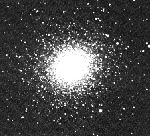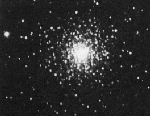Big, Bright & Beautiful in September
Back to Along The Meridian - Big, Bright & Beautiful Index
By Max Gardner AM
After the rich smorgasbord of objects to choose from in the winter Milky Way in August, we must be content with a somewhat less expansive selection this month and for a month or two to come. However, there is still a grand offering of delights awaiting us, especially if we are prepared to look a little deeper for some slightly dimmer but still spectacular objects on the meridian at 10pm this month. While the moon is out of sight and the clouds are absent, let's go outside and have a look around.
Facing the northern horizon and using the line of the Milky Way where it curves to the ground as a guide to the location of the northern end of the meridian, look for the first magnitude star Deneb, located smack in the band of the Milky Way. Move straight up (south) almost 15 degrees, just above the bright second magnitude star Epsilon Cygni. Here lies the huge, complex supernova remnant known as the Veil Nebula. The two major segments are designated as NGC 6960 (the western half) and 6992 (the eastern half). In fact there are several more NGC numbers allocated to this object as it is spread over several degrees of sky in a series of wispy clumps of nebulosity, but all originated in a single stupendous stellar explosion long ago. Much of the structure of the nebula reminds one of streamers of cigarette smoke curling and twisting in delightful patterns that can seemingly be traced for ever, so extensive is it. Of course, bigger apertures will show more of the detail, but the brightest parts this exquisite object can be seen, even dimly, in the smallest scopes. It well repays careful study.
M15
Another 15 degrees due south (up) you will find a small group of about six 4th and 5th magnitude stars in the constellation Delphinus. Just a few degrees west (left) of these stars, near the border of Pegasus and the tiny constellation Equuleus, lies the large, bright globular cluster M15. It has a total magnitude of 6.0, so might be just visible as a naked eye object to those with keen vision at a dark sky site, but is easy to find with binoculars or a finder scope. My observing notes suggest how visually exciting this object can be: "Fully resolved, round, slightly flattened on the western side, with very wide edges, condensing to a small, very intense, almost stellar core. Bright sprays of stars form spectacular patterns across the whole face and beyond. A great object!" It is indeed an excellent example of a globular cluster.
M2
Moving due south again by 13 degrees just across the celestial equator into the constellation Aquarius brings us to another bright Messier globular, M2. With a total magnitude of 6.5 it, too, may just be visible to the naked eye at a dark site, but is an easy binocular target. According to my observing notes it is:
"A very pretty object. Well resolved into a mass of tiny stars. The edges are wide and round, with some flattening on the south side. The core is large, round and dense, but fully resolved. There are bright patterns and sprays of stars extending out past the edges of the cluster."
Another move south by 10 degrees and slightly west, close to the southern border of Aquarius brings us to NGC 7009, the "Saturn Nebula", a bright planetary nebula with a visual magnitude of 8.3. The name derives from its slight similarity in appearance to the famous planet. NGC 7009 has a bright greyish disk from which protrude two rather large, fainter loops or "annulae" which vaguely simulate the far more spectacular rings of its famous namesake. Larger apertures may show some variation in brightness across the disk, even an annulus or ring, and a slightly "ragged" edge to the disk. There is no central star visible to most scopes.
M72
A degree further south and a couple of degrees west of the "Saturn Nebula" lies M72, a rather dim (magnitude 9.3), pear-shaped globular cluster that makes it on to this list simply because of its proximity to NGC 7009. Larger apertures will resolve it and show a wide, regular edge and a small dense core.
M30
Still further south and several degrees to the east of the meridian, in the southeastern corner of the constellation Capricornus, lies the very bright and interesting globular cluster M30. Shining at magnitude 7.3, this object is quite spectacular, especially in larger apertures. According to my observing notes:
"This superb cluster appears much bigger than 11 arc minutes. It starts as a very large, round, background haze condensing gradually to a small dense core. It has very wide edges. Many bright star patterns run to the north, northeast and northwest across the edges into the background field. At a glance, it looks like a jewelled spider on a dewy web! A great globular."
We now move into the vicinity of the zenith (the point directly overhead) in the rather compact and unremarkable constellation of Microscopium. No really bright objects reside here, but in the northwest corner of the constellation lies a single rather large, if dim galaxy, which is worth a look for those with larger apertures. NGC 6925 is an elongated galaxy of magnitude 11.3 that shows some interesting features. My observing notes record:
"A large, bright, elongated galaxy with a long, luminous disk. The disk shows much mottling or structure. It has a very bright, barred core surrounded by a soft round halo or 'bulge'. A good galaxy."
Moving south and east into the north-western corner of the prominent constellation of Grus, approximately one degree west of the 3rd magnitude star Lambda Gruis, is the large planetary nebula IC (Index Catalogue) 5148. Unfortunately it is not marked on Sky Atlas 2000 chart 23, but is shown on chart C59 of the Herald Bobroff Astroatlas. Fairly faint at visual magnitude 11, it displays an annular appearance that can be seen in scopes of quite modest aperture. My observing notes say:
"Shows a large round disk with several outer shells, much enhanced by the O-III filter. The outer disk has a brighter ring structure with variable thickness. Higher power without a filter shows a central star and more structure. An interesting object."
Another nineteen degrees almost due south, in the middle of the inconspicuous constellation of Indus, midway between the 4th magnitude stars Theta and Delta Indii is the very elongated magnitude 10.7 galaxy NGC 7090. My notes of this object read:
"Fine looking, nearly edge-on galaxy. It has a slender, long disk with a slight core, and bulge. Faint knots and structure are seen along the disk. There is a star superimposed on the west end of the disk and another on the north side."
Finally, another three degrees south and east, lying just south east of the 4th magnitude star Epsilon Indii and right on the border dividing the constellations Indus and Tucana, is another elongated galaxy, NGC 7205. It is rather dim at magnitude 11.1, but larger apertures will show a thick, elongated spiral disk with traces of arms and a noticeable dust lane. An interesting object with which to end our tour for this month.
I hope you were able to see most of this month's targets. Those using binoculars and small scopes may have found some of my observing notes, especially those relating to galaxies and planetary nebulae, describe features that were not visible to you. If so, I can only apologise as my observing is done with an 18-inch reflector. While it's great to have the added grunt of those extra inches of aperture, it is surprising how much can be seen in considerably smaller instruments. Next month we move another two hours east to great new fields of objects. See you then.





